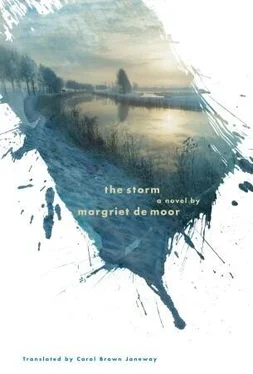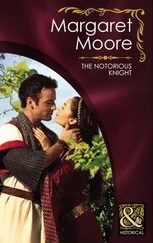The hydrodynamics expert was already buttoning his coat. He stretched out his sturdy arms, took his traveling bag from the rack, and said good-bye. The door to the compartment banged shut, then was immediately pushed open again.
“The sluice here in the canal near Bath. On your way back, get off the train for a few minutes. The water falls freely, there’s no pump involved, fantastic sight. No time? Why? Why? Well, as you wish!”
Armanda said good-bye to him again. Nadja rested her head on her folded arms on the little table by the window, eyes closed. Five minutes later the train stopped in Kruiningen, and even the little woman left her corner of the compartment.
The train continued slowly on its way.
Then, in a velvet stillness caused by a frozen overhead cable, it came to a halt in the middle of what were either meadows or fields. Armanda and Nadja, who’d lit up cigarettes, stared at each other. Pray God we get there in time. How much longer is it going to take? Then they talked about the state of Lidy’s teeth. Twelve fillings. Amalgam. Single surface, two surfaces, and one with three surfaces in first molar, upper left, and another in first molar, upper right. An average set of teeth, very well taken care of, no X-rays ever required.
“Terrible shame,” said Armanda. “He said X-rays would have been the one thing that would have made it still possible to …” She looked rather helplessly at Nadja.
“A classification,” said Nadja, remembering the word from a phone conversation she’d had with Armanda a few days previously. The forensic anthropologist had tried to effect a classification, which is to say, a scientifically provable relation between the bodily remains found in the mud, which were identified for now only with a number, and a real person with a first and last name. The latter was already supplied with a whole series of distinguishing characteristics: sex, approximate age, anatomical build, all investigated meantime and had light shed on them. The approximate date of death together with the location of the remains had naturally led automatically to the Red Cross list of thirty years ago, which still showed the names of 839 missing persons.
“Mama,” said Nadja.
“Yes?”
“Do you really think it’s her?”
Armanda, suddenly deeply upset, looked at her wrist, then at her watch.
“I’ve dreamed about it for two nights now,” Nadja went on, “very intense, very insistent dreams, that it’s the other one, that missing farmer’s wife from … from?”
“Burgh,” said Armanda, in a murmur, because Burgh no longer seemed relevant to her. Having received the same details from the Red Cross, the family there had refused to accept the corpse, rejecting it on the grounds of inadequate facts and in particular because of the jewelry, which had never been part of their traditional costume.
“But it could have turned up in the ground there totally by chance, with no other connection!” Armanda had held this up as a possibility once again on her visit to Rijswijk, eliciting a rather pleading look from the pathologist who was talking to her and answering her questions.
A man of about fifty. Sitting at a desk, tree outside the window. He acknowledged her with a smile, and then stayed with the results of the expert report. The unknown woman and the missing woman could be one and the same; but with certainty — no. Absolutely not.
Armanda had looked down to see the photo of Lidy laughing ante-mortem on the desk. She had reached out her hand and asked what they’d hoped to achieve with the picture. A definitive conclusion, she was told, to the accompaniment of a look that was shattering in its warmheartedness and was maintained for the duration of the discussion that followed. The unknown victim’s teeth were, as he believed she knew, very incomplete, but the alveoli had shown how the teeth had originally been positioned.
She had propped an elbow on the desk and stared at the doctor with her fist against her nose.
“If for example the photo had shown that there was a space between her front teeth, we would have been able to say for sure it isn’t her.”
At this point she’d had a coughing fit, and the doctor had fetched her a glass of water. From this moment on, his appearance merged in her memory with that of the policeman who had come to her house, honest gray eyes, sailor’s beard trimmed short. When she stopped coughing, she had asked, possibly with the help of the tears in her eyes, how drowning actually happens, and how bad it is. She learned in the course of a very long conversation that there are different ways of drowning, in some of which inhaling water is involved, but certainly not always, that if water is inhaled, it doesn’t mean there’s difficulty breathing, because, for example, the victim may already be unconscious, and most important, when there is severe loss of body heat, which is to be assumed in this case, actual death is preceded by suspended animation, a form of slumber that can last for some time and in the course of which the process of metabolism in the brain slows down almost to zero.
So, Armanda asked, is it a peaceful death?
“Yes. Absolutely peaceful.”
The bus that went to Zierikzee by way of the mile-long Zeeland Bridge carried only a handful of passengers. Up front was a group of lounging youths who had left school early, and at the back were the two women who had got in at the train station at Goes, on their way to a burial in Ouwerkerk that had required them to get a special dispensation from the attorney general. Human remains, if discovered in Westerschouwen, must also be buried in Westerschouwen in the absence of verifiable relatives. It’s a requirement of the law regarding burials, because such cases make the local mayor responsible for the costs. The two women sat close together and silent, looking out of the window. They were each wearing a dark coat with a colorful shawl. Despite the first signs of plumpness, the elder of the two, with her loose dark brown hair and a fringe, still looked quite young. The age difference between her and the other one, red-haired, fine-boned, and very pale, didn’t seem that great. Yet the two of them were surrounded with the aura of indefinable calm of a mother and daughter who knew that their lives, in whatever fashion, are intertwined.
Armanda and Nadja, crossing the Oosterschelde.
It was half past one in the afternoon, and the winter sun was casting an almost colorless light on the water, which was still open, still a direct conduit to the North Sea. In two years’ time the work on the flood defenses in the estuary of this arm of the sea would finally be finished. Linked metal barriers of extraordinary dimensions could then be let down in those rare instances when the height of the water beyond exceeded the level on the depth gauge that triggered the alarm; this would protect the land, which needed the flow of the tides, and block it off briefly from the sea. Armanda and Nadja looked at the expanse of water shining glassily in a framework of nothingness. They were fascinated.
“Remember we should buy flowers in Zierikzee,” said Nadja. “We certainly won’t find any in Ouwerkerk.”
The bus stopped in the center of Zierikzee, where the shops were still closed for midday. Armanda and Nadja ate a snack in a café while keeping an eye on the plants in the shop window on the other side of the street.
“We’ll make it,” said Armanda.
They had agreed with the undertaker that they would be there at the cemetery when the hearse arrived at three o’clock with the coffin.
“Look, they’re opening,” said Nadja, and stopped eating.
There weren’t many fresh flowers in weather like this. Armanda and Nadja bought chrysanthemums and had some twigs of eucalyptus and sprays of evergreens tucked in with them, rather reminiscent of Christmas.
Читать дальше












